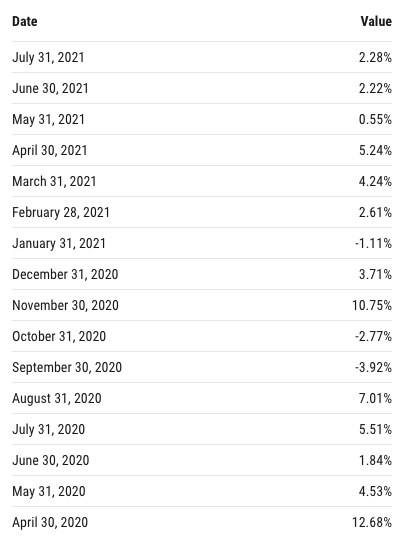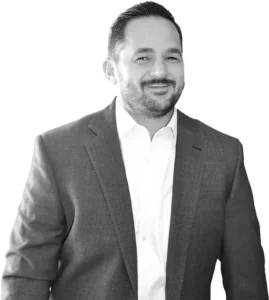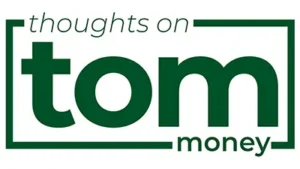The Chinese Food Conundrum
The age-old question: Why am I hungry 15 minutes after eating Chinese food?
Is there a scientific answer?
An ingredient that sparks my appetite?
Or maybe my stomach’s reaction to simple carbohydrates?
Or is it just all in my head?
I may never answer a question, but one truth (or myth) that I know seems upside-down and backward – the concept of eating more resulting in being hungrier.
The Unsatiated Appetite for Risk
In finance, we have a similar mystery; when risk assets (e.g., stocks) perform well, investors have a growing appetite for more risk assets.
I have received more inquiries about “risking up” one’s portfolio in the last few weeks than I have received in the last few years. Why? The market – as measured by the S&P 500 – has been positive 13 out of the last 16 months:

Source: YCharts
Consuming this type of data from the above chart sparks an investor’s appetite for more risk. Hence the influx of inquiries I’ve received recently.
Don’t Grocery Shop Hungry
Now, here’s the problem.
A portfolio should be designed and constructed based on your financial plan. This design should be strategic in nature and be built to weather or endure the typical ups and downs of the typical business cycles. One should not be tinkering on a whim because of a spark in appetite, all based on recent performance.
There is a good reason why you should never grocery shop when you are hungry. Well, at least don’t do it without bringing along your grocery list. If you go into that store without a plan, and your tummy is a rumblin’, you are going to walk out of that store with a whole lot of junk you don’t need.
Often, your eyes are bigger than your stomach.
Eat Your Vegetables
Sometimes the biggest battle in a parent-child relationship is the battle of the vegetables. Mom says to eat them, Dad says you can’t leave the table until you finish them, and little Johnny says, “Yuck!”
Perhaps vegetables aren’t always the tastiest thing on your plate, but the reason mom and dad are pushing for consumption is more for nutritional value and balance than pleasing your palate. Vegetables serve a purpose and an important one at that.
When an investor wants to “risk up” their portfolio, this means they want to buy something (more stocks) and, in turn, will need to sell something in their existing portfolio. In this low-interest rate environment, people are often quick to suggest sacrificing allocations to their boring bonds. Their argument is simple – the yields on these boring bonds aren’t attractive, and I’d rather allocate elsewhere.
These boring bonds are the vegetables of your portfolio. They are there for a reason and serve a nutritional purpose in your portfolio/plan.
Returns & Reserves
If you are a client of mine, you often hear me use this language of “returns” and “reserves.” This is my simplified two-bucket approach to designing and describing an investor’s portfolio.
Reserves, which I equated to vegetables above, are assets that are intended to be (1) accessible (liquid), (2) stable (low volatility), and (3) act as an emergency reserve. The objective of this reserves bucket is not to generate returns. Sure, there will be some associated yield or interest rate, but that’s a bonus, not a primary objective for this bucket.
When investors put these return expectations on their reserves, it’s like expecting their vegetables to taste like ice cream. Again, their purpose in your portfolio is as a safety net. So, now you can see why I object to an investor shrinking their safety net just because stocks are on a hot streak.
We measure reserves based on one’s lifestyle – their expenses. We like to hold multiple (in years) of these expenses in the reserves bucket, which is all mapped out in the financial plan. For some, this will be two years of reserves, for some three years, and for others, it will be a different customized multiple, all based on the uniqueness of their plan.
Diversifying Your Sources of Returns
Your other bucket is the exciting one. This bucket is where you get to collect all of the interesting high potential return assets. Your stocks are one of the assets you store away in this “returns” bucket.
Another common frustration I see is that investors like to line up all these different gems – stocks, real estate, private assets, high yield bonds, etc. – and pit them against one another. We know that all of these assets don’t provide returns in lockstep with one another, so again, recent track records lead investors to pick favorites. They become disenchanted with the “dogs” and inclined to add more resources to the “darlings” of the day.
STOP! Don’t do it.
You want diverse sources of returns that are linked to different aspects of the greater economy. You want this zig and zag behavior because each of these gems will have its day, and owning them in concert with one another builds a more robust and enduring portfolio.
Sticking with our food analogies, you don’t – or at least I hope you don’t – sit down for dinner with a plate full of just roasted potatoes. Your Thanksgiving meal is rife with diversification – the turkey, the stuffing, the cranberries, the mash potatoes, the gravy, the green beans, the yams, and, and, and…
Moral of the Story
When I eat Chinese food, sometimes my stomach (or my mind) plays tricks on me – I feel hungry, but God knows I have already consumed way more than enough calories.
When the stock market is on a hot streak, sometimes my mind (or my gut) plays tricks on me – I feel tempted to tinker with my portfolio and add just a wee bit more risk, but I need to follow the plan/approach I already have in place.
Your reserves are meant to act as a safety net, and you want to be well equipped for when unfortunate times surface. Sometimes these unfortunate events will extend across the economy and the greater population of investors, but other times they will be unique to just you and your life. You need to be well prepared.
Always remember, the expectations you have for your “returns” bucket are very different than that of your “reserves” bucket. One bucket is stable and accessible, while the other has the potential to drive significant returns – if you confuse your expectations here, you are sure to be disappointed.
Lastly, there is value in diversification, and specifically diversifying your sources of returns. Diversification can feel unnecessary at the moment, but it is crucial in the long run.
Next steps? Review your allocations, your portfolio, and your plan. Make sure everything is designed optimally and calibrated to your expectations.







